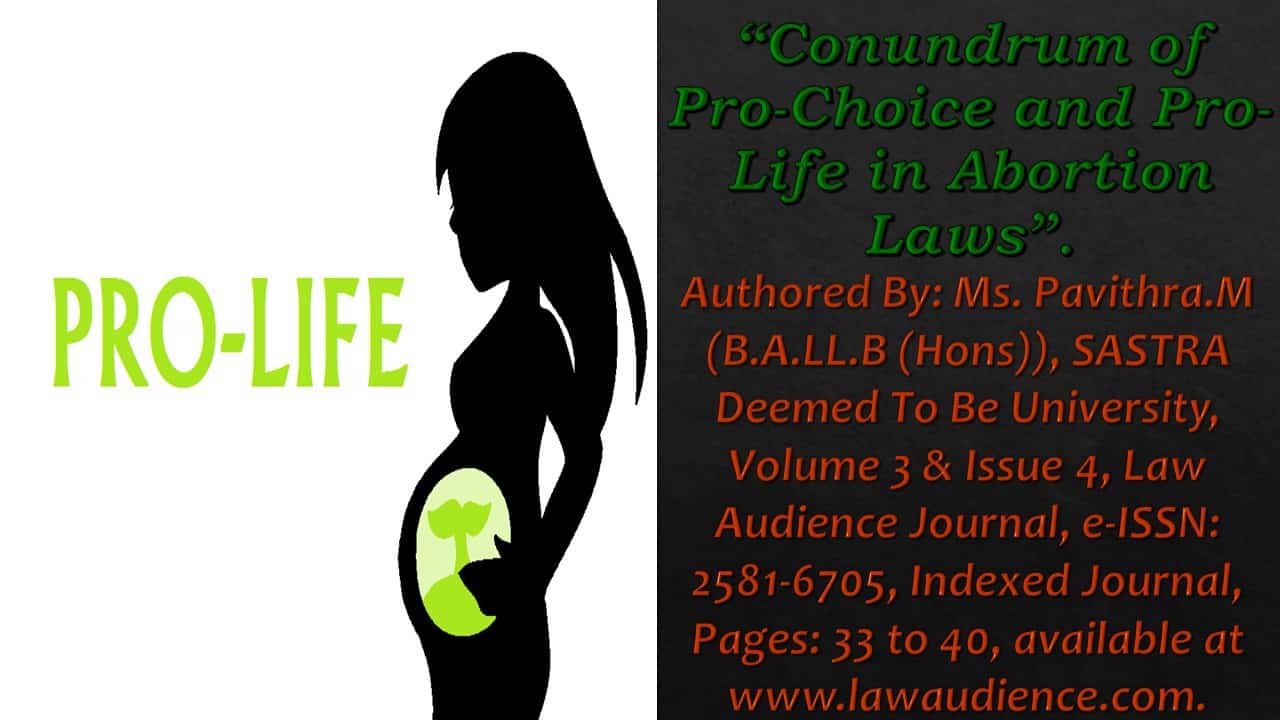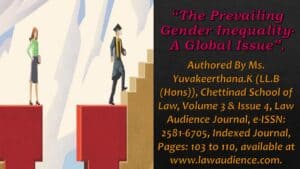Click here to download the full paper (PDF)
Authored By: Ms. Pavithra.M (B.A.LL.B (Hons)), SASTRA Deemed To Be University,
Click here for Copyright Policy.
ABSTRACT:
“The legalization of abortion in India under various circumstances for the last 50 years has brought a dramatic improvement in the women’s health and reductions in maternal and infant mortality rate. For young women, low-income women however the access to abortion has been increasingly restricted. This article describes the obstacles to access abortion, restrictive law, stigmatization and marginalization of abortion, decreasing abortion services and shortage of providers”.
I. INTRODUCTION:
Abortion is a highly charged and emotional subject that involves some highly controversial and complicated issues of law, medicine and morality. Pro-life and pro-choice are conundrums of abortion. The pro-life want to control a women’s reproductive decisions, even denying contraceptives, a women’s first line of defence against being impregnated. Pro-choice supports a women’s right to solve her reproductive decisions. The problem of unwanted pregnancy and its termination is a perennial problem. A newly elected American Senator said that it was the toughest issue he had ever dealt on 20 years of his public life.
The chasm which exists between the abolitionists of the control on abortion and the proponents of a ban on it is due to wide divergence in moral and policy perspectives. Those who stand for the ban do it specifically for protection of human life at whatever stage of development it may be and quite often on the additional ground that legislation would lead to permissiveness in society and damage to the institution of marriage and family and laxness of morals. Religion and law for a long time have been on the side of those who are for the ban.
II. RELIGIOUS VIEWS:
Christianity particularly the roman catholic church and Islam prescribe very stringent injunctions against abortions. Ancient Hindu culture and traditions were absolutely opposed to it. It was regarded as murder of the foetus (bhrun hatya)[1]. The catholic churches opposition to abortion can be gauged by the statement made by the pope pius XI in 1930 in which he asserted that abortions is forbidden, even to save a women’s life, because the foetus is equally sacred. This goes even beyond the legal ban in many countries where abortion is used in circumstances to save the mother’s life.
III. ABORTION LAWS AND THEIR ENFORCEABILITY:
In a large number of countries, before the recent liberalization, abortion was considered as crime except where there is a necessity to save the life of the mother.
Section 312 of IPC says,
312.Causing miscarriage –whoever voluntarily causes a women with child to miscarry shall, if such miscarriage be not caused in good faith for the purpose of saving the life of the women, be punished with imprisonment for either description of term which may extend to three years, or with fine or both; and if the women be quick with child, shall be punished with the imprisonment of either description for a term which may extend to seven years and shall also be liable to fine.
Sections 313, 314, 315 and 316 relate to the more special cases of abortion.
The laws of abortion are generally flouted; this in fact in one of the arguments of the abolitionists. Whenever enforcement is there due to religious beliefs, medical ethics and the fear of social censure and no credit can be therefore to be given to the law enforcement agencies. From time immemorial all kinds of ingenuities have been practised by women, the world over to get undesired pregnancies terminated.
It is also true that from ancient times men have opposed abortion because of their deep concern for the foetus and the allegation is that abortion laws, in a way represent male values; the values of “inseminators” rather than of the “bearers”. The laws are not enforceable mainly because of the nature of the crime. Law or no laws, a women needing an abortion and keen to get it shall be able to get it in any case, a quack if not qualified person, is sure to make his service available. The crime has been treated as one ‘without a victim’.
IV. EXTEND OF THE PROBLEM:
In a study of 5000 white non-prison females, Dr. Kinsley reported that by that time they were 45 years of age and 22 percent of married women had one or more induced abortion. According to a report published in 1969, there were 2,00,000 to 15,00,000 illegal abortions each year in America[2]. In 1979 the total number of reported abortions was 15,40,000 abortions increase of more than 100 percent since 1973 when the law was rendered more liberal as a result of the decision taken in American supreme court in roe vs. wade[3].
Japan and Hungary probably have the highest abortion rates in the world. About 50 percent of pregnancies are aborted. In India the number of abortions is estimated to be between four to six million every year. According to a statement made in Lok Sabha, there were 2,24,669 legal abortions performed in India during the year 1977.
V. DAMAGE TO ILLEGAL ABORTION:
Legal restrictions on abortion create a thriving market for the supply of illegal services catering to the forces of demand. Illegal abortions give rise to a number of problems and hazards which are cited by the abolitionists.
- Many deaths are caused in the process of illegal abortions since they are frequently performed by those who are not competent to do. Compared to married women single girl is even more exposed to this kind of risk since in her case the causes may be more compelling for her to seek a non- qualified person. Even if the operation is performed in unsafe manner after care and emergency steps are not sometimes possible in illegal abortions since they are performed in a clandestine.
- Illegal abortions give rise to the emergence of some kind of black market in services which inevitably lead to inflated fees. The equality and the availability of the services depend upon one’s Capacity to pay.
- Illegal services cause illegal organization of all those who are concerned with illegal abortions. It also promotes police corruption.
VI. LIBERALIZATION OF LAWS:
The Medical Termination of Pregnancy Act, 1972 has liberalized the position to a great extent in India. A legal operation can be performed by a registered medical practitioner within the first 20 weeks of pregnancy.[4] The pre-natal diagnostics techniques like amniocentesis and sonography through useful for the detection of genetic or chromosomal disorders or congenital malformations or sex-linked disorders, are being used on large scale to detect the sex of the foetus and to terminate the pregnancy, if the unborn child is found to be a female. Techniques are also being developed to select the sex of the child before conceptions. These practices and techniques are discriminatory to the female sex and not conducive to the dignity of women. It can also precipitate a catastrophe in the form of severe imbalance in the male-female ratio.
In a typical Indian family, because of the well-known social, economic and cultural factors the arrival of female child is quite unwelcome to say the least. A test like amniocentesis, therefore, has the potential of the gross criminal abuse and is currently playing havoc; unscrupulous and greedy doctors being available in plenty to provide illegal services to needy clients. Some doctors and private hospitals go even to the extent of advertising the facilities available and the message, in spite of being a bit subtle, is clear and unambiguous.
Parliament therefore passed the Pre-natal Diagnostic Techniques (Regulations and prevention of misuse) Act, 2002, which sought to ban the pre-contraception selection techniques and the misuse of pre-natal diagnostic techniques for sex-selective abortions and to provide for the regulation of such abortions. The act provided for the constitution of supervisory boards in states and the union territories to monitor the implementation of the provisions of the act and to create public awareness against the practice of pre-conception sex selection and pre-natal determination of sex of the foetus leading to female foeticide. The act also prohibits advertisements relating to pre-conception and pre-natal determination of sex and prescribes punishment for the contraventions.
In STATE OF H.P VS. NIKKU RAM AND OTHERS,
A two-judge bench of the supreme court expressed its agony thus, “Dowry, dowry and dowry.” this is the painful repetition which confronts, and at times haunts, many parents of a girl child in this holy land of ours where, in good old days the belief was: ‘’Yatra naryastu pujyante ramente tatra dewantan”(where women is worshiped, there is abode of god).”
In VINOD SONI & ANR VS. UNION OF INDIA[5],
In 1994 the PCPNDT Act was challenged on the ground that it violates Article 21 of the constitution to the extent it includes the liberty of the choosing the sex of the child. The petition was dismissed by the Bombay High court and the act was held constitutional.
The Medical Termination of Pregnancy (Amendment) Bill, 2021, is for expanding access of women to safe and legal abortion services on therapeutic, eugenic, humanitarian or social grounds. The amendments include substitution of certain sub-sections, insertion of certain new clauses under some sections in the existing Medical Termination of Pregnancy Act, 1971, with a view to increase upper gestation limit for termination of pregnancy under certain conditions and to strengthen access to comprehensive abortion care, under strict conditions, without compromising service and quality of safe abortion.
The Bill was approved in Lok Sabha on 17th March 2020. The Rajya Sabha has approved the Medical Termination of Pregnancy (Amendment) Bill, 2021 to amend the Medical Termination of Pregnancy Act, 1971 on 16th March 2021.
The salient features of the Medical Termination of Pregnancy Amendment Act;
1. Enhancing the Upper Gestation Limit:
Enhancing the upper gestation limit from 20 to 24 weeks for special categories of women which will be defined in the amendments to the MTP Rules and would include-
- survivors of rape,
- victims of incest and
- other vulnerable women
- (Like differently-abled women, minors) etc.
2. Provider’s Opinion:
Opinion of only one provider will be required up to 20 weeks of gestation and of two providers for termination of pregnancy of 20- 24 weeks of gestation.
3. Constitution of Medical Board:
The composition, functions and other details of Medical Board to be prescribed subsequently in Rules under the Act.
4. Confidentiality of Women:
Name and other particulars of a woman whose pregnancy has been terminated shall not be revealed except to a person authorized in any law for the time being in force.
5. Ground of Failure on Contraception:
The ground of failure of contraceptives has been extended to women and her partner.
Many women will be benefitted by Amendment Act as recently several petitions were received by the Courts seeking permission for aborting pregnancies at a gestational stage beyond the present permissible limit on grounds of foetal abnormalities or pregnancies due to sexual violence faced by women. Recently several petitions were received by the Courts seeking permission for aborting pregnancies at a gestational age beyond the present permissible limit on grounds of foetal abnormalities or pregnancies due to sexual violence faced by women. The amendments will increase the ambit and access of women to safe abortion services and will ensure dignity, autonomy, confidentiality and justice for women who need to terminate pregnancy.
In KOMALAVALLI VS. C.R NAIR[6],
The petitioner mother of two children was gang raped and became pregnant. subsequently she was put up in a women’s welfare institution. She applied under ART. 226 of the constitution of India for a direction to government maternity hospital to terminate her pregnancy. The court while allowing her petition, observed that the continuation of such unwanted pregnancy would lead to traumatic and psychological shock. Therefore, the court allowed the termination of pregnancy by a qualified gynecologist without any detriment to her life and safety. Similar approach was taken in KM.MAHIMA VS. STATE[7] and D. RAJESWARI VS. STATE OF TN.
VII. CONCLUSION:
The world health Organizations say 21.6 million unsafe abortions are estimated to occur globally every year, causing the deaths of 47,000 women. From statistics like these show unsafe abortions represent 12% of all maternal deaths, the issue isn’t really about numbers. It is about individuals and communities coming to terms with life and death.
The role of government should be to provide people the freedom necessary to pursue their own goals, emphasize the empowerment of the individual to solve problems, personal responsibility and individual liberty.
It is better if we opt for pro-choice because I think in many cases morality is deeply lacking if what we want is a child born but not a child fed, not a child educated, not a child housed.
The anti-abortion pro-life, No.1 priority is the birth. Pro-choice supports women who want to be mothers at the time of choosing.
Bibliography:
I. Statutes:
- Medical Termination of Pregnancy Act, 1972.
- Pre-natal Diagnostic Techniques (Regulations and prevention of misuse) Act, 2002.
- Medical Termination of Pregnancy Amendment Act, 2021.
- Indian Penal Code, 1860.
II. Books:
- Medical law and ethics in India ; Eastern law house; edited by Sandeepa Bhat.
- Ahmad Siddique’s Criminology Penology and Victimology, University of Delhi.
- Health law by Dr. Ishita Chaterjee.
Cite this article as:
Ms. Pavithra.M, “Conundrum of Pro-Choice and Pro-Life in Abortion Laws”, Vol.3 & Issue 4, Law Audience Journal (e-ISSN: 2581-6705), Pages 33 to 40 (4th March 2022), available at https://www.lawaudience.com/conundrum-of-pro-choice-and-pro-life-in-abortion-laws/.
Footnotes & References:
[1] Paripurnanand Varma, Sex Offences in India and Abroad (1979).
[2] Time, 13-10-1967.
[3] Liberalisation of Laws.
[4] Women’s health; undesired pregnancy due to failure of contraception; the pregnancy being the result of rape or some other unlawful intercourse; these are some of the permissible grounds under the Act.
[5] 1994.
[6] 1984 CR LJ 446.
[7] 2003 VIAD Delhi 510.





